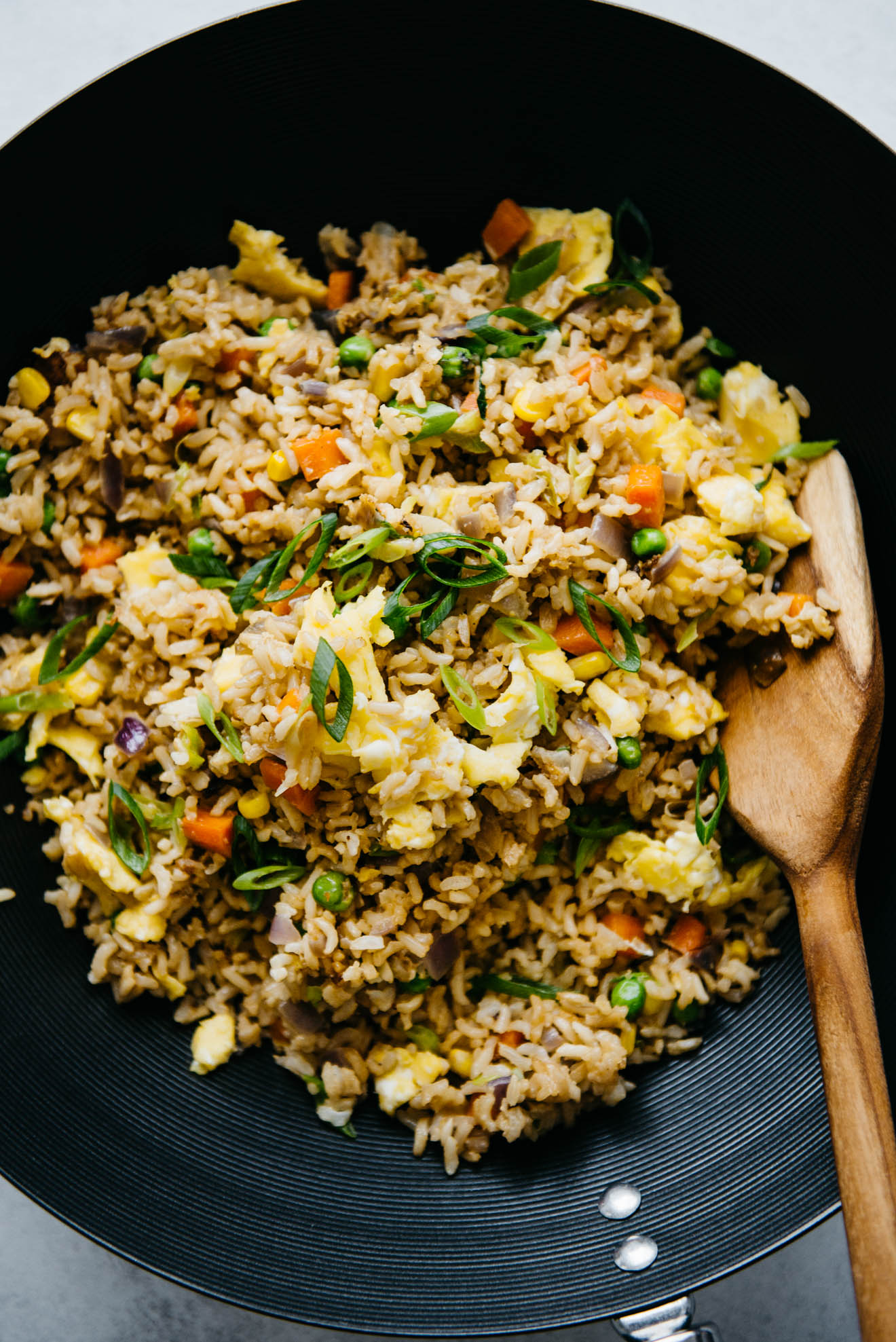Fried Rice, with or without Egg
MAKES: 4 to 6 servings
TIME: 20 minutes with cooked rice
A little more complex than the preceding recipe, made just like a standard stir-fry: You choose your other main ingredients in whatever combination you like here, vegetables and tofu, at least to start and cook them one or two at a time, each in a little bit of oil (a nonstick or well-seasoned pan is an essential piece of equipment) over high heat, until they are pretty much done. Then set them aside in a bowl.
Add a bit more oil and the basic aromatics, like garlic and ginger, followed by the rice. When that is hot and glossy, you can add an egg or two if you like, return the cooked ingredients to the mix, and add soy sauce and other seasonings.
The quality and freshness of the dish will be a revelation. Vegan without the eggs.
1 cup fresh or frozen peas
3 tablespoons peanut or neutral oil, like grapeseed or corn
1 medium onion, roughly chopped
1 bell pepper, cored, seeded, and roughly chopped
11/2 cups cubed firm tofu
1 tablespoon minced garlic, or to taste
1 tablespoon peeled and minced fresh ginger, or to taste
3 to 4 cups cooked white or brown rice (start with about 11/2 cups raw), preferably basmati or jasmine
2 eggs, lightly beaten (optional)
1/4 cup Shaoxing wine, sherry, white wine, stock, or water
2 tablespoons soy sauce
1 tablespoon dark sesame oil
Salt and freshly ground black pepper to taste
1/4 cup minced scallion or fresh cilantro
If the peas are frozen, soak them in cold water to defrost while you begin cooking. Put 1 tablespoon of the oil in a wok or large skillet over high heat. A minute later, add the onion and bell pepper and cook, stirring occasionally, until they soften and begin to brown, 5 to 10 minutes. Lower the heat if the mixture threatens to scorch. Use a slotted spoon to transfer them to a bowl.
Add the tofu and cook, again over high heat, stirring infrequently, until nicely browned, 5 to 10 minutes. Add to the bowl with the vegetables. Drain the peas if necessary and add them to the skillet; cook, shaking the skillet, for about a minute, or until hot. Add them to the bowl.
0Put the remaining oil in the skillet, followed by the garlic and ginger. About 15 seconds later, begin to add the rice, a bit at a time, breaking up any clumps with your fingers and tossing it with the oil. When all the rice is added, make a well in its center and break the eggs into it if you’re using them; scramble them a bit, then incorporate them into the rice.
Return the tofu and vegetables to the pan and stir to integrate. Add the wine and cook, stirring, for about a minute. Add the soy sauce and sesame oil, then taste and add salt and pepper if necessary. Turn off the heat, stir in the scallion, and serve.
Variations
Basic Fried Rice with Frozen Vegetables. No apologies; this is better than you might think: For the peas, substitute mixed peas and carrots or peas, carrots, and corn. You can even use frozen bell pepper strips if you like and probably never notice.
Basic Fried Rice, Thai Style. In Thailand, they call this Chinese food: In Step 4, stir in a teaspoon or two (or to taste) red curry paste (to make your own, see Red Curry Paste). Garnish with cilantro and scallion.
Basic Fried Rice with Lettuce. Surprised? Try it: In Step 4, stir in 2 cups thinly sliced iceberg or romaine lettuce.
Pineapple Fried Rice. Undeniably popular, for good reason: In Step 4, stir in 11/2 cups chopped fresh pineapple (or, okay, you can use canned, but unsweetened please, and drained) when adding the rice; adding a diced tomato at the same time, along with a little ketchup, will give you a more complex and fun-looking dish. Proceed with the recipe.
13 Good Additions to Fried Rice
The list of things you can add to fried rice is longer than the list of things you cannot. But they basically fall into three categories: vegetables, protein, and seasonings.
Vegetables:
- Very tender vegetables, or those that can be eaten raw, can be stirred in at the last minute, like the lettuce in the variation.
- Those that will cook in about the same amount of time as the onion or pepper (scallion, shredded zucchini, corn kernels, etc.) should be cooked with or instead of the onions.
- Harder vegetables broccoli, cauliflower, eggplant, potato, winter squash should either be cut into very tiny bits, so they will cook in just about the same amount of time as the onions, or quickly parboiled (or deep-fried if you prefer) before incorporating as any other vegetable.
- Tomatoes are a special case: Cut them into small wedges and add just after the rice, or you will have tomato sauce. (Not that there’s anything wrong with that, and if that’s what you want, add the tomatoes when the onions are about half cooked.)
- You can also garnish with raw vegetables, like cucumbers made according to the Quick-Pickled Vegetables recipe, chopped cabbage, or tomato wedges.
Protein:
- Any tofu—smoked, pressed, flavored, frozen and thawed, you name it—is great here. Add as you would the tofu in the main recipe.
- Also good are cubed or crumbled tempeh or seitan. I like to fry them in a little oil as if they were a vegetable.
- Hard-cooked egg is another good option, either chopped or sliced and added right after the rice.
Seasonings:
- Fresh chiles, minced, at the beginning, or chile paste of any kind at the end, always to taste.
- Hoisin sauce (or ketchup; they’re really not that different), stirred in just after the rice.
- Basil (preferably Thai) 10 or 15 big leaves, torn up and added at the last moment, instead of or in addition to cilantro.
- Curry powder or almost any other spice mix (to make your own, see Spice Mixtures), stirred in just before you add the rice.
- Nori Shake is good, as are toasted sesame seeds (see The Nut and Seed Lexicon).








